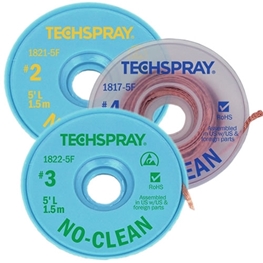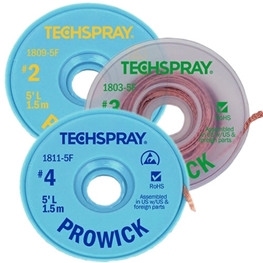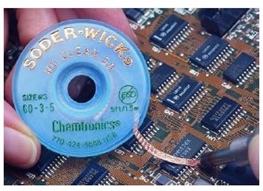Desoldering braid or desoldering wick is a pre-fluxed copper braid that is used to remove solder allowing components to be replaced and excess solder (e.g., bridging) to be removed. The soldering iron is applied to the wick as it sits on the solder joint, and when both reach the solder's melting point, the flux is activated and, through capillary action from the braided design, solder is drawn up the wick. Techspray wick has been a mainstay at PCB rework, repair and prototyping stations for over 30 years.
It is available in static dissipative bobbins for static sensitive environments, and in two different flux types as well as unfluxed:
- No-Clean desoldering braid - coated with proprietary flux that only leaves a slight clear residue, which does not cause dendritic growth, corrosion, or other service issues. Cleaning after using Techspray No-Clean wick is optional.
- Pro-Wick desoldering wick - coated with a fast-activating rosin flux for lightning-fast solder removal.
- Unfluxed desoldering braid - ideal for customers that use an aqueous flux or who are required to maintain the same flux throughout board assembly and rework.
All Techspray desoldering braids are effective solder removers, are effective on lead and lead-free solders, are compliant with RoHS, and do not contain SVHC as defined by REACH.
Specifications: Meets or Exceeds MIL-F-14256; NASA NHB 5300, 4 (34-1); NASA NPC 200-4; NASA SP5002; 1821:HP 8690-0588; 1823: HP 8690-0577; IPC Standard-J-STD-004
 No-Clean Desoldering Braid
No-Clean Desoldering Braid
FAQ's
In a production or repair environment where the flux is specified and can’t be changed, or when an aqueous flux is needed, you can add your own flux to this type of braid. Unfluxed wick will not remove solder unless flux is added. TraceTech No-Clean Flux Pen is formulated to perform at the elevated temperatures of lead-free soldering but is also effective for tin-lead soldering as well. It's designed with a low surface tension to prevent bridging. Post-soldering cleaning is optional because the light residue left after soldering is barely noticeable is non-corrosive and halide free. This is a good choice for tin-lead soldering where cleaning is to be avoided.
Yes, a soldering iron is necessary when using desoldering braid (wick). Please see our plato tips here.
All you need is Techspray desoldering braid (wick) and a soldering iron. Here are the basic instructions: 1) Place the braid over unwanted solder, preferably on the greatest solder build up so that it maximizes the contact of the braid to the surface area of the solder. 2) Next, place your iron tip over the wick at 45 degrees and allow heat to transfer to the pad. Molten solder will absorb into the braid. 3) Move the solder tip and braid as needed to remove all of the solder at one time. Careful not to drag the braid over the pads, which can scratch. 4) Once the braid is full of solder, you must trim the spent portion and move to fresh braid in order to pull more solder. Remove the iron and braid simultaneously to avoid soldering the wire to the board.






